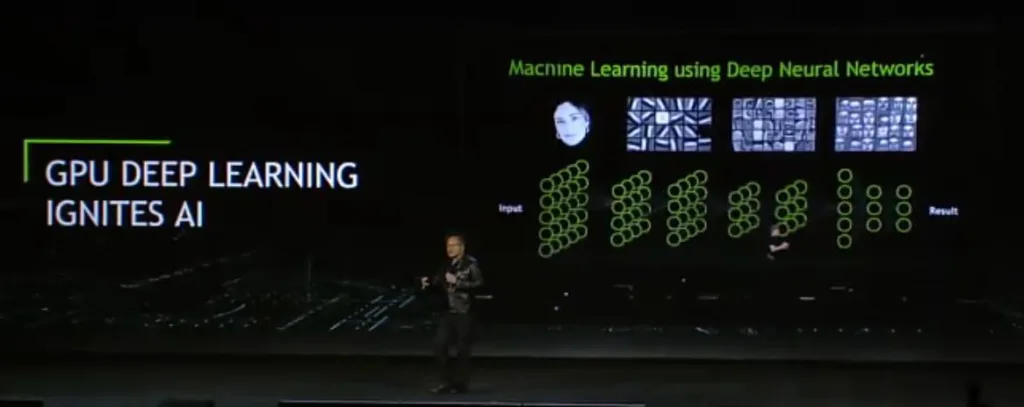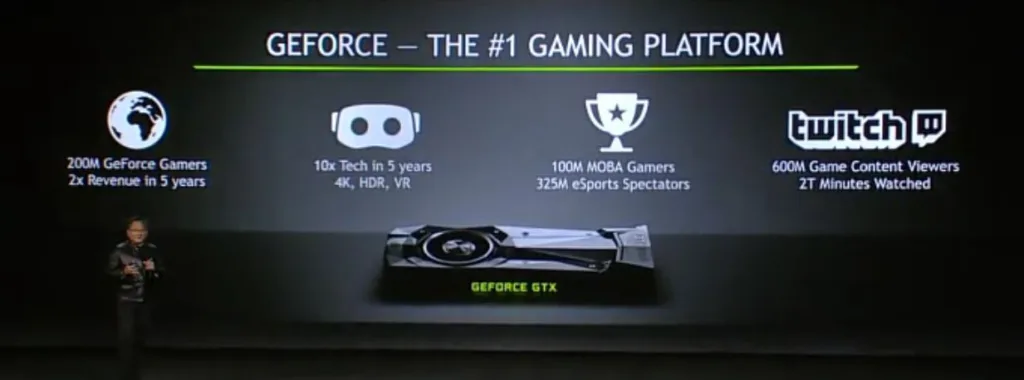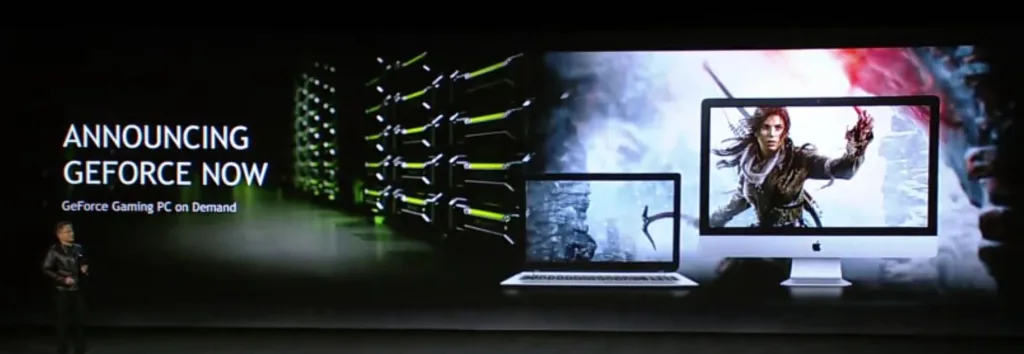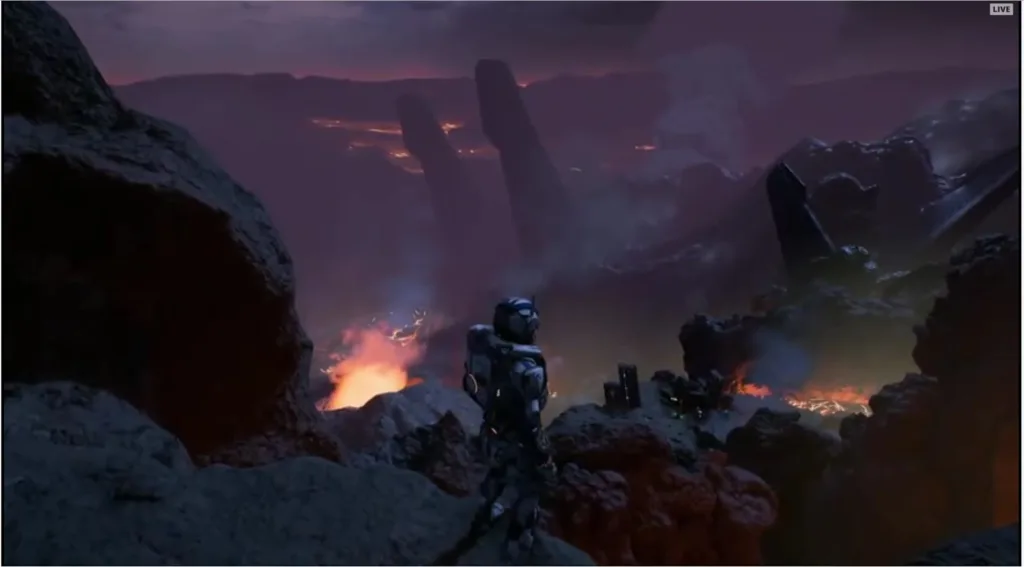The conclusion of Jensen’s presentation summed up his nearly 1-1/2 hour keynote presentation at CES 2017:
We want to bring video games to everyone. We want to turn your home into an AI, we believe your home will engage in natural simple ways. We want to turn your car into an AI and revolutionize the automobile and bring joy and safety to millions of people.
Of course, gaming is also at the center of NVIDIA’s core business, so they also announced a partnership with Facebook, and a way to make triple-A PC gaming available to anyone with a notebook PC or almost any Windows or Mac computer.
NVIDIA has had an exceptional year in 2016 with their stock almost doubling in value since they released their latest Pascal GPU architecture in Austin, last May. They are the definition of “hot” as their GPUs are being used in training neural networks for artificial intelligence, and they are in most of the world’s fastest supercomputers, in self-driving cars, used for virtual reality, and for PC gaming. Regular readers of BTR are quite familiar with NVIDIA’s vision which is detailed by our annual visit to NVIDIA’s GTC (GPU Technology Conference).
NVIDIA’s CEO Jensen was picked to deliver the primary CES keynote speech this year in front of a packed hall of 3,000, a keynote usually reserved for Intel, Microsoft, Samsung, or Qualcomm. And NVIDIA did not disappoint as Jensen made one major announcement after another.
 After giving the history of NVIDIA, beginning with video games which was always about achieving a virtual reality, Jensen talked about what he called the big bang of AI – machine learning – programming software to write software by recognizing complex patterns and by building upon self-created simpler patterns by using self-teaching deep neural networks. This requires harnessing the parallel processing power only the GPU can provide. For more details of the incredible accomplishments that these deep neural networks have made, check out NVIDIA’s GTC 2016 Wrap-Up.
After giving the history of NVIDIA, beginning with video games which was always about achieving a virtual reality, Jensen talked about what he called the big bang of AI – machine learning – programming software to write software by recognizing complex patterns and by building upon self-created simpler patterns by using self-teaching deep neural networks. This requires harnessing the parallel processing power only the GPU can provide. For more details of the incredible accomplishments that these deep neural networks have made, check out NVIDIA’s GTC 2016 Wrap-Up.
Of course, NVIDIA began its GPU business with PC gaming which is in an incredible growth phase. What has fueled this growth is the production value of games as the tech has improved over tenfold. And gaming has become the world’s largest sporting event with over 100 million MOBA players and over 325 million spectators, Video games have become a more than 30 billion dollar a year industry and NVIDIA’s GeForce platform has doubled in five years to over 200 million GeForce gamers. This has allowed NVIDIA to make some remarkable profits which has driven research and development into other areas which use the same GPUs powering their video cards.
GeForce Experience is NVIDIA’s gaming platform that automatically updates drivers and optimizes settings, allows gamers to stream their games, and now it connects directly to Facebook in a new partnership. And in another new announcement, NVIDIA has expanded its GRID service to gamers as GeForce NOW.
GeForce NOW
GeForce NOW is a streaming service that delivers a high-performance gaming PC from the cloud to PC and Mac computers to gamers who otherwise would not be able to play demanding PC games on their notebooks or on older PC. This new service connects gamers to NVIDIA’s video cards in cloud data centers and streams them in high definition to PCs and to Macs.
NVIDIA has done this on a smaller scale with SHIELD, but now it will charge gamers $25 for up to 20 hours of play, depending on what configuration the player has. This service will allow a gamer to save their game in the cloud and synchronize them with locally installed games across multiple PCs. It’s similar to Netflix, but instead it is a powerful GeForce PC on demand for gamers.
Early access to the new GeForce NOW service is scheduled for March in the continental United States, with full commercial service slated for the Spring. Gamers can sign up now for the early access waiting list.
 One of these games might be Mass Effect: Andromeda, one of the most anticipated games of 2017, and never-before-seen by the public gameplay was demonstrated playing smoothly on a GTX 1080. This game will be released on March 21, 2017.
One of these games might be Mass Effect: Andromeda, one of the most anticipated games of 2017, and never-before-seen by the public gameplay was demonstrated playing smoothly on a GTX 1080. This game will be released on March 21, 2017.
Jensen next turned his attention to television, launching the new SHIELD TV streamer.
SHIELD TV
NVIDIA’s new SHIELD TV is an Android open-platform media streamer that uses cutting edge technology to deliver experiences in streaming, gaming, and AI.
NVIDIA claims 3x the performance of any other currently available streamer. With the addition of Amazon Video in 4K HDR, SHIELD will offer the largest and most open catalog of media which also supports Netflix, YouTube, Google Play Movies and VUDU. In addition, YouTube’s flagship TV app will also be available for SHIELD to deliver 360-degree viewing experiences in the coming months.
SHIELD TV is unique among media streamers with its huge assortment of game content. Its library of games has been expanded to thousands of titles, and soon it will stream Ubisoft’s gaming catalog.
There are more plans for SHIELD to include AI capabilities for entertainment including the first hands-free Google Assistant integration on TV. Google has optimized the Assistant experience on TV by having a home’s primary screen give visual answers in addition to an audio reply. It will also utilize voice commands which will replace clicking a remote. Google Assistant can even assist in finding content and in answering questions.
NVIDIA SPOT was also announced as an AI microphone accessory that makes SHIELD the center of the AI home, extending intelligent control throughout the house and connecting smart home devices.
SHIELD TV is available for pre-order now and will ship in the United States, Canada and select European regions later this month for $199.99, including controller and remote. SHIELD Pro will also be available later this month with an additional 500GB of storage. The NVIDIA SPOT mic accessory for SHIELD will sell separately for $49.99.
Transportation AI
NVIDIA is planning to revolutionize the ten trillion dollar transportation industry by eliminating waste. Because humans drive vehicles, the losses of life, property and productivity, and human suffering is large. Jensen suggested that humans shouldn’t drive cars but rather should be co-pilots with AI.  NVIDIA’s new AI car computer is called the AI Co-Pilot. It’s aware of the driver and aware of the passenger. It will also give the car’s occupants an array of speakers and mics much like SPOT does for the home. So the AI car is either driving you or looking out for you. If it’s not confident to drive, it should still be completely aware and be able to assist the human driver.
NVIDIA’s new AI car computer is called the AI Co-Pilot. It’s aware of the driver and aware of the passenger. It will also give the car’s occupants an array of speakers and mics much like SPOT does for the home. So the AI car is either driving you or looking out for you. If it’s not confident to drive, it should still be completely aware and be able to assist the human driver.
To achieve this, NVIDIA created an AI car supercomputer called Xavier. It’s a small SOC that can process 30 trillion operation a second using only 30 watts and it uses a 512 core next generation Volta GPU. Its reliability is auto grade which is quite serious, and to show Xavier off, NVIDIA has developed their own self-driving car called BB8.
As part of NVIDIA’s strategy for self-driving cars, they have collaborated with HERE HD Live Map which is cloud service supporting all levels of vehicle automation. It is already commercially available for North America and Western Europe. Through multiple modes of sensors, it can update itself, with its data layers assisting the vehicle in positioning, localization and strategy planning. Localization using the HERE HD Live Map on the NVIDIA DRIVE PX 2 AI computer uses deep learning to pinpoint the vehicle’s position, as well as to detect how the environment around the car may differ from the current map. Road tests are already taking place as part of this collaboration. And NVIDIA is also collaborating with ZENRIN, Japan’s leading mapping company, to develop a cloud-to-car HD map solution for self-driving cars. Similarly, NVIDIA already partners with Baidu in China and with TomTom in Europe.
Localization using the HERE HD Live Map on the NVIDIA DRIVE PX 2 AI computer uses deep learning to pinpoint the vehicle’s position, as well as to detect how the environment around the car may differ from the current map. Road tests are already taking place as part of this collaboration. And NVIDIA is also collaborating with ZENRIN, Japan’s leading mapping company, to develop a cloud-to-car HD map solution for self-driving cars. Similarly, NVIDIA already partners with Baidu in China and with TomTom in Europe.
To get their AI computers into the automotive industry, NVIDIA is now partnering with ZF, the leading trucking and commercial vehicle suppliers in Europe. They are first to announce a production DRIVE AI computer which will ship later this year. And another new NVIDIA partner is Bosch, the number-one automotive tech supplier in the world, which supplies every car company in world and will also adopt the DRIVE computer.
NVIDIA’s oldest automotive partnership is with Audi and they announced they will work with Audi to build the next generation of AI cars that will be powered by NVIDIA’s AI car computer and they will have these cars on the road by 2020. 
Impressive!